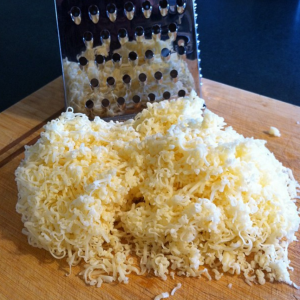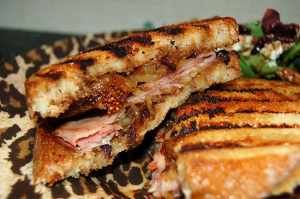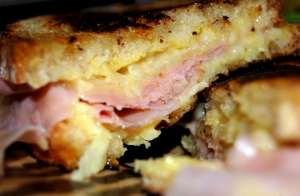Fontina cheese is a distinctive type of Italian cow cheese coming from the milk of cows fed at very high mountain altitudes with specific kinds of grass that give the cheese its distinct flavor. Fontina cheese was first made back in the 12th century in the Alps regions of Italy and the region still remains the main producer of Fontina cheese. Other than this, the cheese is now also produced in the USA, France, and the rest of Italy.
Fontina cheese is a semi-firm cheese. This makes it very versatile as it is often found on cold cheese plates, but also used as a melting cheese ideal for pizzas or pasta, so commonly made in Italian cuisine. The melted cheese can also be used in a number of sauces commonly used in Italy. We wanted to find out how nutritional Fontina is, what kind of dishes is it used for, and what is best to use as a Fontina cheese substitute if we can’t find the actual stuff. Nutritionally speaking, Fontina is a bomb. 100 grams of this cheese contains 390 calories, a pretty high number. The cheese is super rich in fats, having 31 grams of fat per 100 grams of the cheese, 19 grams of that being the saturated fats, which are the worse kind.
Fontina Cheese Nutrition
Nutritionally speaking, Fontina is a bomb. 100 grams of this cheese contains 390 calories, a pretty high number. The cheese is super rich in fats, having 31 grams of fat per 100 grams of the cheese, 19 grams of that being the saturated fats, which are the worse kind. Fontina is very rich in protein, however, with 26 grams of protein per 100 grams of cheese, equal to most meats out there. The cheese also contains a bit of carbohydrate, under 2 grams per 100, and 116 grams of cholesterol per 100 grams of cheese, which is really high.
Fontina cheese is also very salty, and the sodium intake from 100 grams of it will amount to 33% of your RDI. Looking down at the vitamin and mineral composition, the highlights of Fontina are the Calcium, Phosphorus, Zinc, Selenium, Vitamin B12 Vitamin A, and Vitamin K2 which can all be found in fairly high percentages. In fact, eating 100 grams of Fontina will give you 55% of your RDI for Calcium.

Fontina Cheese Substitute
Fontina cheese is really great, but the fact is that in many parts of the world it is not really available and even where it is, you won’t exactly find it in every single supermarket. This is why people often ask what is a good cheese substitute. The truth is, Fontina does not have any special features past its flavor and standard cheeses such as Gouda, Emmentaler or Provolone will do the trick just fine.
If you are trying to cook pasta, pizza, or a sandwich that has Fontina on the recipe ingredients list and can’t find this stuff, try other semi-firm cheeses. Use the one you like the most flavor-wise and the fact is that nothing bad will happen. We hope as you read this article you better are better understand the various types of cheese substitutes.
Fontina Cheese Health Implications
When it comes to your health Fontina has implications both ways. On the one hand, it is very fat and caloric, which you usually don’t want, but on the other, it is rich in protein and vitamins and minerals, which actually makes it good. So let us examine the implications in more detail.
Vitamin K2 has been shown to be very important to keeping a healthy skeleton. A serving of Fontina will give you over 150% of the recommended daily intake for this vitamin, so this is a definitive plus.
Vitamin B12 has been proven to prevent heart issues such as stroke and even cancer as well as help protein and fat turn into energy. A serving of Fontina gives you about 40% of the daily Vitamin B12, another great stat.
Next, up we have Calcium. As I mentioned 100 grams of Fontina will give you over 50% of your RDI for Calcium, which is a really important mineral for bone structure. Combined with Vitamin K2, this cheese is really great for your bones.

Phosphorus and Zinc are also two minerals found commonly in this cheese in high amounts and they are both crucial to our bodies functioning properly, from cell level to brain function, reproduction, and immune system, these minerals need to be taken in regularly to keep a healthy body.
Finally, for the good stuff, Fontina has a lot of protein, and I mean a lot of it. This cheese comes in the same rank as chicken breast which is one of the highest protein-rich foods, and that makes it a fantastic source of protein. 26 grams per 100 grams of cheese, as I said earlier.
Now, on to the negatives. The fact is that no matter how much good Fontina can do for your system, it is simply super-rich in fats. And what is even worse, it is mostly saturated fats. Eating 100 grams of Fontina will give you just about 100% of your RDI for saturated fats and this is excluding all other meals of the day. The same amount will also have 400 calories, which is again a very high number.
To summarize the health implications I will say that eating 35 to 50 grams of Fontina cheese daily (not every day either) will do great things for your health. Eat much more than that, and your organism will not be able to deal with it, and you will gain weight and experience the negative consequences we all know are associated with obesity and high cholesterol levels.
Conclusion
Fontina cheese is one of the tastiest cheeses out there and can be used as a great topping for pizzas and pasta, part of various sauces as well as a cold plate dish. Eating it in moderation is truly good for you, as it contains all sorts of great nutrients, but eating too much can lead to obesity. Be sure to dose your Fontina properly and you will gain from both the health benefits and the fantastic flavor of this Italian premium cheese.
Image Rights
Images used via the creative commons license version 2.0 – https://creativecommons.org/licenses/by/2.0/
Image one by Amber DeGrace – https://www.flickr.com/photos/ink_mama/6411368141/
Image Two by ILoveButter – https://www.flickr.com/photos/jdickert/604155429/
Image Three by ILoveButter – https://www.flickr.com/photos/jdickert/474147867/
